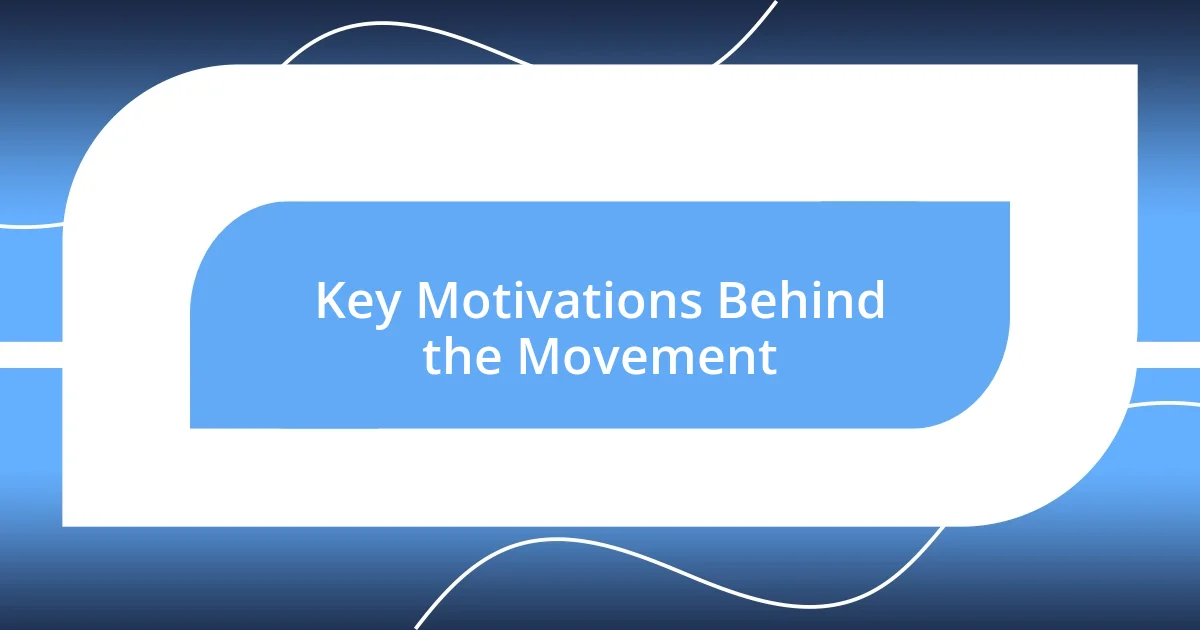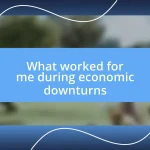Key takeaways:
- Transnational movement is driven by a mix of economic opportunities, education, family reunification, and escape from conflict, shaping individual and community identities.
- Historical events like industrialization, wars, and globalization have significantly influenced migration patterns, creating diverse transnational communities.
- Personal experiences highlight the importance of resilience, cultural exchange, and the fluid concept of belonging, encouraging deeper connections across borders.

Understanding Transnational Movement
Transnational movement, at its core, involves the flow of people, ideas, and resources across national borders. It’s fascinating to me how interconnected our world has become—whether through migration driven by economic opportunity or cultural exchange, every movement tells a story. Have you ever thought about the reasons people choose to leave their homes? It’s often a mix of necessity and hope, which can be both heart-wrenching and inspiring.
Reflecting on my own experiences, I remember speaking with a friend who moved from her small village to a bustling city abroad for education. She recounted the excitement of starting fresh, yet there was an undeniable pang of homesickness. This duality is common in transnational experiences—individuals often struggle with maintaining their cultural identity while assimilating into a new environment. Doesn’t that resonate with anyone who’s navigated unfamiliar terrains both physically and emotionally?
Moreover, understanding transnational movement means recognizing its impact on communities. When I think about the blend of cultures, cuisines, and languages that emerge from such movements, I can’t help but feel a sense of gratitude. It enriches our global tapestry and opens our eyes to perspectives we may never have encountered otherwise. How can we truly appreciate the depth of our interconnectedness without acknowledging these shared journeys?

Historical Context of Transnationalism
Transnationalism didn’t emerge overnight; it evolved as a response to historical global changes. The waves of migration in the late 19th and early 20th centuries, driven by factors such as industrialization and colonialism, set the stage for the interconnected world we navigate today. I often think about how my great-grandparents journeyed from their homeland, seeking a better life. Their resilience, much like that of many transnational families today, highlights the profound motivations that underlie such movements.
Over the decades, events such as wars, economic crises, and globalization have further fueled transnational flows. For instance, when I learned about the impact of the Syrian refugee crisis on neighboring countries, it struck a chord with me. It made me reflect on the lengths people will go to for safety and opportunity. It’s a powerful reminder of how interconnected our individual stories are with the larger narrative of humanity, showcasing both challenges and triumphs.
In today’s world, transnationalism intersects with technology and communication. I feel we often take for granted our ability to connect instantly with loved ones across the globe. This phenomenon enables cultural exchanges and strengthens ties among people from diverse backgrounds. Yet, it also raises questions about identity and belonging. How do we maintain our roots while branching out into new soil? It’s a delicate balance that’s more relevant than ever.
| Historical Event | Impact on Transnationalism |
|---|---|
| Industrialization | Increased migration for job opportunities and urbanization. |
| World Wars | Displaced populations, creating new transnational communities. |
| Globalization | Facilitated cross-border trade and communication, enhancing cultural exchange. |

Key Motivations Behind the Movement
One of the key motivations behind the transnational movement is the pursuit of better opportunities. I recall my cousin’s story vividly when he decided to move abroad in hopes of landing a job in the tech industry. The excitement in his voice when he talked about the potential to learn and grow was matched only by his anxiety about starting over in a foreign land. This drive for personal growth and security often propels people to take the leap into the unknown.
Motivations driving transnational migration often include:
- Economic Opportunity: The quest for jobs, better income, and improved living standards.
- Education: Many seek higher educational prospects unavailable in their home countries.
- Family Reunification: Individuals frequently relocate to join family members who have already settled elsewhere.
- Escape from Conflict: War, violence, and persecution push countless people to seek refuge in other nations.
When I talk to friends who’ve immigrated for familial reasons, the stories convey a bittersweet longing. They revel in the joy of reunions yet carry memories of those left behind. It’s fascinating how such intricate motivations shape lives and build communities that are both vibrant and complex.

Personal Experiences with Transnationalism
I’ve often found myself reflecting on my own family’s history with transnationalism. My parents moved to the United States in search of a better future, leaving behind the comforts of home. I remember the stories they told me about their first winter; they faced not just the cold weather, but also the challenge of navigating a new culture. Their bravery inspires me every day, reminding me that the journey toward the unknown can lead to incredible growth and opportunity.
A few years ago, I reconnected with a childhood friend who had moved back to her native country after living abroad for several years. Listening to her describe the feeling of being torn between two worlds struck me deeply. She loved her new life, yet the memories of her past were always with her. It’s a complex emotion, isn’t it? Balancing nostalgia with the excitement of new experiences seems to resonate with many transnational lives I’ve encountered.
There are moments when I ponder how technology plays a role in this transnational experience. I often chat with friends living overseas through video calls, which makes it feel like they’re just a heartbeat away. Yet, there’s a disparity that often surfaces during these conversations—their daily lives feel so distant from mine. How do we truly belong in two places at once? It’s a question that lingers, hinting at the deeper layers of identity shaped by transnational connections.

Influence of Global Networks
Global networks play a vital role in shaping transnational experiences. I’ve seen firsthand how social media helps loved ones maintain connections despite physical distance. I might be thousands of miles away from friends, yet a simple message can bridge that gap instantly. Isn’t it amazing how we can share moments in real-time, from birthdays to everyday coffee breaks, even when we’re continents apart?
Every time I talk to my uncle, who lives in another country, I’m reminded of the powerful influence these global connections have. He often shares insights about cultural exchanges, showing me how ideas and traditions flow freely across borders. Through his stories, I feel a deeper understanding of his life abroad and how he navigates his dual identity. It begs the question: can we truly appreciate our roots while embracing a new culture? I think we absolutely can, as long as we keep those conversations alive.
Moreover, the networks formed through these connections often lead to opportunities, whether in the form of collaborative projects or shared resources. I once witnessed a friend launch an initiative that helped young immigrants find jobs in their new communities, inspired by her own experiences of struggle and support. This interplay of global connections and local engagement belongs to a larger narrative of growth—not just for individuals, but for the communities they contribute to. How do we harness these global networks to create lasting impact? I believe it starts with open dialogue and mutual support.

Lessons Learned from Transnational Examples
The lessons learned from transnational examples often revolve around resilience and adaptability. I recall a time when I volunteered at a local nonprofit assisting immigrants. One woman shared her story of arriving with her family during a tumultuous political climate. Her determination to learn the language and find employment despite the odds taught me that challenges can inspire strength. Isn’t it remarkable how adversity can become a catalyst for growth?
Another important lesson is the value of cultural exchange. My participation in a multicultural festival opened my eyes to how diverse backgrounds enrich our communities. I watched as food, music, and art from different cultures created a tapestry of shared experiences, fostering unity rather than division. It made me realize that through understanding one another, we can build bridges instead of walls. Do we truly appreciate the wealth hidden in our differences, or do we sometimes overlook it?
Finally, the concept of belonging takes on new dimensions in transnational contexts. I once attended a virtual reunion with colleagues from around the world. What struck me was how each person shared what home meant to them, despite living in different countries. This interaction made me ponder: can ‘home’ be more than a physical place? I believe it can, as we define it through relationships and shared experiences across borders. Understanding this fluidity encourages us to connect on deeper levels, both personally and globally.

Applying Insights to Personal Life
Applying insights from transnational experiences into my personal life has been a transformative journey. I remember a summer spent in a vibrant community that welcomed newcomers from various countries. I was initially struck by the rich tapestry of languages and backgrounds, but what truly moved me was how these differences nurtured friendships and understanding. I often wonder, how can we foster such an inclusive environment in our everyday lives? I believe it starts with open-mindedness and the willingness to embrace the unfamiliar.
In reflecting on my professional life, I’ve found that networking across borders enhances my perspective on collaboration. Recently, I collaborated with a colleague from another continent on a project. While we faced time zone challenges, our conversations enriched my approach, bringing in fresh ideas I hadn’t considered before. It raises an intriguing thought: could our differences be our greatest asset rather than a hindrance? I’m convinced they are, as each interaction opens doors to innovative solutions and collective growth.
Culturally, I’ve started to incorporate aspects from different traditions into my daily routine. For example, participating in a tea ceremony from a friend’s heritage introduced me to a sense of mindfulness I hadn’t embraced before. I often ask myself, why limit our experiences to what’s familiar? By embracing diverse practices, I feel more connected to the world around me. This exploration not only enhances my life but also builds a bridge of understanding and appreciation for the richness that diversity brings.














